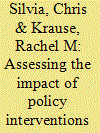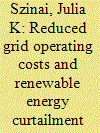| Srl | Item |
| 1 |
ID:
149986


|
|
|
|
|
| Summary/Abstract |
Heightened concern regarding climate change and energy independence has increased interest in plug-in electric vehicles as one means to address these challenges and governments at all levels have considered policy interventions to encourage their adoption. This paper develops an agent-based model that simulates the introduction of four policy scenarios aimed at promoting electric vehicle adoption in an urban community and compares them against a baseline. These scenarios include reducing vehicle purchase price via subsidies, expanding the local public charging network, increasing the number and visibility of fully battery electric vehicles (BEVs) on the roadway through government fleet purchases, and a hybrid mix of these three approaches. The results point to the effectiveness of policy options that increased awareness of BEV technology. Specifically, the hybrid policy alternative was the most successful in encouraging BEV adoption. This policy increases the visibility and familiarity of BEV technology in the community and may help counter the idea that BEVs are not a viable alternative to gasoline-powered vehicles.
|
|
|
|
|
|
|
|
|
|
|
|
|
|
|
|
| 2 |
ID:
150768


|
|
|
|
|
| Summary/Abstract |
Recent U.S. state and federal legislation have been implemented with the intent of promoting the diffusion of plug-in electric vehicles (PEVs). Meanwhile, the federal government has passed new regulation aimed at increasing fuel efficiency standards of gasoline powered vehicles in order to reduce greenhouse gas emissions. In this paper, we examine the existing barriers that impact PEV diffusion. We argue that increased fuel efficiency standards coupled with declining gasoline prices conflicts with the implemented PEV incentives. Using a geospatial method, we demonstrate how policymakers can create regionally weighted markets based on consumer surveys to facilitate the development of a national policy for nascent products like the PEVs.
|
|
|
|
|
|
|
|
|
|
|
|
|
|
|
|
| 3 |
ID:
169845


|
|
|
|
|
| Summary/Abstract |
Widespread adoption of plug-in electric vehicles (PEVs) and renewable energy (RE) can help to jointly decarbonize the transportation and electricity sectors. Previous studies indicate strategies to manage PEV charging facilitate integration of RE into electricity grids, but the value of such strategies at scale is unclear because electricity markets and PEV charging have been inadequately represented together. This analysis focuses on the state of California in 2025, and improves on prior work by linking high-resolution mobility and grid dispatch models to quantify the value of managed charging under a 50% RE grid and PEV adoption scenarios up to California's 5 million vehicle target. Even after accounting for practical charging and grid constraints, 0.95 to 5 million “smart” charging PEVs avoid $120 to $690 million in California grid operating costs annually (up to 10% of total costs) and reduce RE curtailment up to 40% relative to unmanaged PEVs. Overnight time-of-use (TOU) charging provides similar cost savings but increases curtailment. Both of these managed strategies defer system infrastructure expansion at the 5 million PEV deployment. The results suggest residential smart charging complemented by TOU tariffs with added daytime periods are policies with most potential to advance California's dual PEV and RE goals.
|
|
|
|
|
|
|
|
|
|
|
|
|
|
|
|